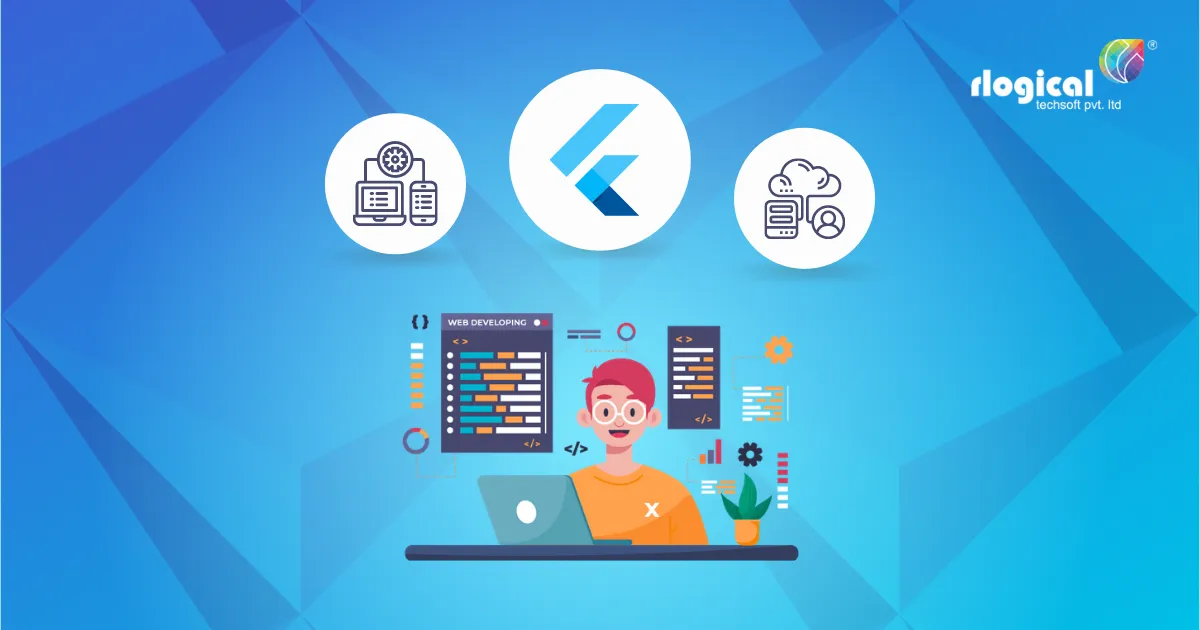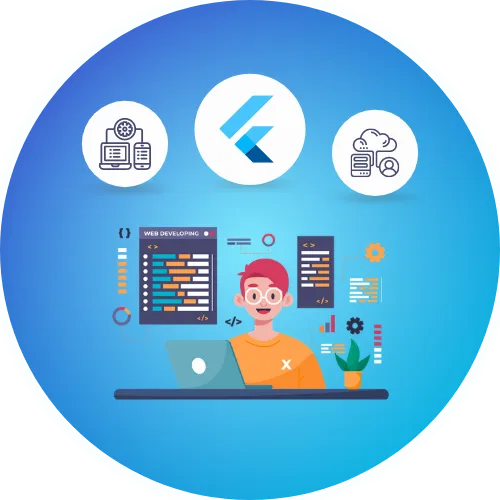
It is a fact that technology is evolving, and this is witnessed by us every day when we are exposed to innovative technology out there. However, at present, mobile app development has become quite popular amongst customers, particularly those companies which are looking to create mobile apps for them. You’ll come across quite a few programming tools on the market these days to serve the mobile application development requirement. Flutter happens to be one of these well-known programs regarding which we will talk about in the following paragraphs.
What exactly is Flutter?
Google is responsible for creating Flutter. It happens to be an open-source application development kit employed for cross-platform or hybrid mobile application development. This implies that the application created using Flutter can be run on various operating systems such as Windows, iOS, Android, Linux, Mac, and the web making use of a single codebase.
Flutter had been introduced as a beta version known as “Sky” in the year 2015. In 2018, a Flutter stable version was launched by Google, which was known as Flutter 1.0. Following this, it began to become popular in mobile hybrid app development.
The most recent version of Flutter was released in 2019 in the form of Flutter 1.12. This particular version had been launched by resolving 5303 problems and 5970 pull requests from approximately 470 contributors across the globe.
Flutter 1.17 was launched in the year 2020. In this particular version, the iOS device’s performance improved, Metal API had been added along with network tracking tools.
Developers make use of Dart, a programming language, for writing Flutter code.
Must Read: Flutter 1.22 Stable Release is out for Android 11 and iOS 14 Features
What exactly is Dart?
This is a programming language that Google has created. It was used for developing web servers, mobile applications, as well as utilities for IoT gadgets. This language had been updated to Dart 2.8 from Dart 2.7. This updated version at present provides several advantages.
The code which was written in this language was compiled by making use of JavaScript. Writing code in Dart is almost identical to writing code in C# and Java.
Why would it be a good idea to invest in Flutter?
1. Cross-platform approach
It will be a sensible idea to make Flutter a cross-platform mobile application to reach the maximum number of users. Nevertheless, in the recent past, the user experience of hybrid mobile apps was not good. One significant reason for this is the fact that the developers must produce a UI experience in JavaScript. There comes Java, Kotlin, Objective -C, or Swift. This area has been hit very effectively by Flutter. It will provide you with the advantage of writing code only once while creating fantastic native apps with top-notch performance and cross-platform ability.
2. Save expenses
On most occasions, it is imperative to hire developers having respective skill sets while creating iOS and Android apps. This is quite expensive in the long run. On the contrary, since Flutter supports both iOS and Android, it will be possible to hire only one developer, which can be quite inexpensive. Consequently, create the Flutter application along with the core features and update afterward depending on client feedback. This will aid in saving time as well as money.
3. Ideal for creating MVP App
App development using Flutter leverages lots of innovative features. It happens to be a comprehensive framework that enables you to create platform-independent apps and which function on the web, mobile, and desktop technologies. Consequently, it will be possible to plan and also target the release of an app across every single platform in one go. This is appropriate for MVP (Minimum Viable Product) and beneficial for businesses that like to create these MVPs. This provides them with immense opportunities for market capitalization.
While using Flutter, you will be able to create top-notch applications that can be developed using widgets with a small team of professionals. Moreover, it is likewise budget-friendly.
4. High productivity is provided by the hot reload feature
It is the innovative hot reload feature of Flutter, which is responsible for productivity improvement. A Flutter mobile application developer can detect any change almost instantaneously, and the structure of the app changes within 10 seconds. Consequently, you will be able to see the modifications while you are making them. A Flutter developer can frame UIs and hold errors quicker. The changes made are almost instantaneous, which will reduce the reload time and additional time on emulators, simulators, and hardware for Android and iOS platforms.
5. Portability
Apart from being a framework, Flutter is likewise a comprehensive SDK that will be able to run on any device having a screen. Consequently, you will be able to run Flutter applications on Windows, Mac OS, and Linux along with third-party ports. It will be feasible to include keyboard and mouse input functions, embedding APIs, and different plug-ins. Considering the preference of Google for IoT gadgets, it can be expected that this functionality will get official in the upcoming days.
6. The open-source package helps to make development quite simple
Flutter happens to be open-source, which helps to develop the app at a quicker speed. You will come across plenty of additional packages, which helps make the task quite manageable in the long run. Similar to other open-source projects, this package library goes on developing by leaps and bounds. Moreover, it should be mentioned here that the credit should be given to the experienced developers who happen to be contributing continuously to the Flutter community. Furthermore, these multiple packages will help to grow the all-encompassing technical community as well.
Must Read: What makes Rlogical the best Flutter App Developer?
7. Only one codebase
Only one version of the app will be running for Android and iOS platforms when it comes to Flutter development. This is referred to as a single codebase. As a result, the developers and designers will be focusing only on creating just a single codebase for both of these platforms.
8. The usage of Dart
Flutter makes use of Dart, an object-oriented programming language. It offers several innovative features such as garbage collection, robust typing, the standard library, generics, etc.
9. Making use of customizable widgets
The developers are provided an option of using widgets by Flutter according to their requirements. Here, everything that the developer’s design happens to be a widget and making UI. Apart from this, another useful addition is the layout which aids in defining the position, size, and state of the widgets.
10. Robust design experience
Flutter provides different themes for iOS and Android apps. Apart from varying in color, the themes likewise differ in style and size. A trusted platform has been built by it for extraordinary UIs, and the applications serve various domains such as entertainment, education, e-commerce, utility, social, fitness, and health.
11. Simpler animations
Flutter adds the flexibility of API for including animations. Even a small code while using Flutter will allow you to include easy as well as expressive animations
12. Native themes for Android/iOS
The quest of application development has been made quite streamlined by Flutter using local codes, platform APIs, and third-party incorporations.
13. IDEs are supported by Flutter
In case Flutter development is selected by you, you will be choosing from lots of IDEs. It will be a sensible idea to initially commence with Android Studio, and then you can move to Visual Code, which is fast and light.
Advantages and disadvantages of Flutter mobile development
There is no secret that every solution comes with its advantages and drawbacks, which can simplify or impede the development of mobile apps somewhat. Flutter offers some significant advantages which attract app owners and developers out there. These advantages are as follows:
- Comparatively quick development aids in saving you plenty of time, money, and effort. Flutter enables you to use an identical codebase similar to other cross-platform technologies for creating separate Android and iOS applications. This helps accelerate the entire development process and implies that you do not require two teams to work on the code.
- The “hot reload” feature of Flutter makes it quite simple to modify the existing code and view the outcomes in the app preview immediately without recompiling the code. In this way, it will be possible to fix errors, and you can do experimentation with different features and UI elements.
- Quick rendering and full customization thanks to the layered architecture of Flutter. It provides you with control over each pixel and allows you to overlay plus animate videos, graphics, and text without limits.
- Flutter likewise functions for the web and provides proper documentation, thus enabling you to verify the functioning of native controls.
However, despite having these positive aspects, Flutter also comes with some drawbacks, which we have highlighted below.
- Applications made in Flutter are rather large as well as heavy. Lots of space is occupied by them, and they also take a considerable amount of time for downloading or updating.
- You will not come across any single “guideline” in developing apps in Flutter, which can prove to be quite problematic while creating more complicated applications.
Conclusion
It is not difficult to learn Flutter, which is meant for everybody out there, even though you might be having less experience regarding the development of mobile apps. Moreover, the development is quite simple and effortless, thanks to the presence of libraries and widgets. Although Flutter uses dart as the default programming language, it can also be fused with other languages such as Java and Swift. Consequently, Flutter and Dart help improve performance, safety, and tools for hybrid mobile app development.
Jatin Panchal
Jatin Panchal is the Founder & Managing Director at Rlogical Techsoft Pvt. Ltd. For more than a decade, he has been fostering the organization's growth in the IT horizons. He has always bestowed personalized approaches on .NET, PHP, Flutter, and Full-Stack web development projects. From startups to large enterprises, he has empowered them to accomplish business goals. By delivering successful industry-driven solutions, he is encouraging the capability of AI, ML, blockchain, and IoT into custom websites and hybrid mobile applications.
Related Blog
- How to Develop and Deploy Your PWA (Progressive Web Application) Using Flutter?
- Top Flutter App Development Companies to Hire App Developers For Your Next Project
- Vue Native and Flutter: Comparison Between Top Frameworks
- Top Flutter Widgets Are Best To Use for App Development
- Top 5 BaaS, You Can Opt for Your Flutter Application
Categories
- All
- AI Development Services
- Amazon Web Services (AWS)
- ASP.Net Development
- Azure Web App
- Big Data Analytic
- Customize
- Digital Marketing
- Drupal Development
- E-commerce web development
- Education Mobile App Development
- Enterprise Application
- Event Management App Development
- Fintech
- Fitness App Development
- Food Delievery
- Front-End Development
- Grocery App Development
- Healthcare App Development
- Hire Dedicated Developers
- Hotel Booking App
- IT Industry
- JavaScript Development
- Mobile App Development
- On Demand App Development
- On Demand Healthcare App Development
- PHP Development
- POS Software Development
- Real Estate Mobile App Development
- Retail Business App Development
- Salesforce
- Social Media Development
- Software Development
- Technology
- Transportation App Development
- UI/UX Design
- Web Design
- Web Development
- Web Services
- Web/Data Scraping Services
- WordPress




 Jatin Panchal in Hire Flutter App Developers
Jatin Panchal in Hire Flutter App Developers 






